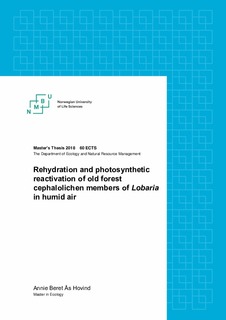| dc.contributor.advisor | Gauslaa, Yngvar | |
| dc.contributor.advisor | Phinney, Nathan Harris | |
| dc.contributor.author | Hovind, Annie Beret Ås | |
| dc.coverage.spatial | Norway | nb_NO |
| dc.date.accessioned | 2018-10-11T10:51:16Z | |
| dc.date.available | 2018-10-11T10:51:16Z | |
| dc.date.issued | 2018 | |
| dc.identifier.uri | http://hdl.handle.net/11250/2567613 | |
| dc.description.abstract | Most lichens tolerate desiccation, yet sufficient hydration remains a general prerequisite to photosynthesis and growth. Species-specific morphologies likely reflect important hydration traits and may therefore provide insight to niche preferences and species ranges. This study quantifies and compares kinetics of rehydration in humid air and concurrent PSII reactivation in the co-occurring yet morphologically and functionally distinct cephalolichens Lobaria amplissima, L. pulmonaria and L. virens. High-temporal resolution monitoring of rehydrating thalli by automatic weighing combined with chlorophyll fluorescence imaging of maximal PSII efficiency (Fv/Fm) was applied to determine species-specific rates of water vapor uptake and photosynthetic activation. The thinner thalli of L. pulmonaria and L. virens rehydrate and reactivate faster in humid air than the thicker thalli of L. amplissima. The thin and loosely attached lobes of L. pulmonaria are especially well-designed for water vapor harvest, providing a flexible hydration strategy consistent with its broader geographical distribution, which stretches from rainy coastal forests to humid continental forests. The thick, resupinate L. amplissima reactivates more slowly in humid air, but can store greater amounts of water when provided in abundance, prolonging active periods after saturating hydration events. This water conserving strategy could represent an advantage where abundant rain or stem flow alternates intense drying. Understanding the links between morphological traits, functional responses and their ecological implications for species at risk is crucial to conservation planning and has the potential for modelling populations under various climate scenarios. | nb_NO |
| dc.language.iso | eng | nb_NO |
| dc.publisher | Norwegian University of Life Sciences, Ås | nb_NO |
| dc.rights | Attribution-NonCommercial-NoDerivatives 4.0 Internasjonal | * |
| dc.rights.uri | http://creativecommons.org/licenses/by-nc-nd/4.0/deed.no | * |
| dc.subject | Lobaria | nb_NO |
| dc.subject | Poikilohydry | nb_NO |
| dc.subject | Cephalolichen | nb_NO |
| dc.subject | Rehydration | nb_NO |
| dc.subject | PSII reactivation | nb_NO |
| dc.subject | Chlorophyll fluorescence imaging | nb_NO |
| dc.subject | Functional traits | nb_NO |
| dc.title | Rehydration and photosynthetic reactivation of old forest cephalolichen members of Lobaria in humid air | nb_NO |
| dc.type | Master thesis | nb_NO |
| dc.description.version | submittedVersion | nb_NO |
| dc.subject.nsi | VDP::Matematikk og Naturvitenskap: 400 | nb_NO |
| dc.source.pagenumber | 40 | nb_NO |
| dc.description.localcode | M-ECOL | nb_NO |

